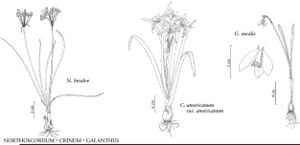Difference between revisions of "Galanthus"
Sp. Pl. 1: 288. 1753.
Gen. Pl. ed. 5, 140. 1754.
imported>Volume Importer |
(No difference)
|
Latest revision as of 04:55, 30 July 2020
| Taxon | Illustrator ⠉ | |
|---|---|---|
 | Nothoscordum bivalve Crinum americanum var. americanum Galanthus nivalis | Yevonn Wilson-Ramsey Kimberly J. Martin Kimberly J. Martin |
Herbs, perennial, scapose, from brown, tunicate, ovoid to globose bulbs; offset bulbs often present. Leaves 2 (–3), basal, opposite, with sheathing blade, vernation flat and parallel, or convolute; nonsheathing blade erect to recurving at maturity, grayish green, linear-oblanceolate, glaucous; sheathing blade white, tubular, membranous, enclosing leaf-bases and scape. Scape erect in flower, prostrate in fruit, green, solid. Inflorescences pendulous, 1-flowered, spathaceous; spathe bracteate, membranous; bracts 2, connate, split on 1 side. Flowers nodding, fragrant; perianath 2.5 cm or shorter; tepals 6, distinct, unequal; outer tepals spreading, white, narrowly obovate to almost orbicular, larger than inner; inner tepals overlapping, appearing tubular, green-spotted at apex only or apex and base, straight to semiorbicular, apex notched; stamens 6, inserted at bases of tepals, distinct; anthers basifixed, longer than filaments, bases lobed, apices tapered, dehiscense introrse, via terminal slits; ovary inferior, green, 3-locular, globose, septal nectaries present; style, white, unbranched, filiform; stigma indistinct to minutely capitate; pedicel wiry, short, slender. Fruits capsular, green, globose, fleshy, dehiscence loculicidal. Seeds 18–36, light-brown, 3.5 mm, oblong to obtuse, elaiosomes fleshy. x = 12.
Distribution
Introduced; Europe, sw Asia (Asia Minor), sw Asia (Iranian Caucasus), sw Asia (and Caspian Sea regions), and naturalized elsewhere
Discussion
Species 14–17 (2 in the flora).
A number of Galanthus species, especially G. nivalis, are commonly cultivated for their late- winter and early–spring flowers, which emerge through the snow. Species of Galanthus are sometimes confused with Leucojum, snowflakes, a spring-flowering relative. The plants of Leucojum are usually taller, bear 2–3 flowers per stem, and their tepals are all equal.
Selected References
None.
Lower Taxa
Key
| 1 | Inner tepals blotched with green at base and apex or with green stripe from base to apex; leaves convolute within basal sheath. | Galanthus elwesii |
| 1 | Inner tepals blotched with green at apex only; leaves flat and parallel within basal sheath. | Galanthus nivalis |
"broad" is not a number."thicker" is not a number.